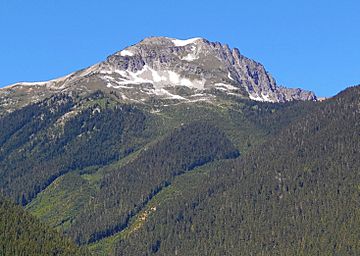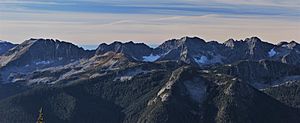Beebe Mountain facts for kids
Quick facts for kids Beebe Mountain |
|
|---|---|

Beebe Mountain seen from the east
|
|
| Highest point | |
| Elevation | 7,416 ft (2,260 m) |
| Prominence | 1,056 ft (320 m) |
| Isolation | 1.56 mi (2.51 km) |
| Parent peak | Elija Ridge (7,739 ft) |
| Geography | |
| Location | Whatcom County, Washington United States |
| Parent range | North Cascades |
| Topo map | USGS Crater Mountain |
| Climbing | |
| Easiest route | Scrambling |
Beebe Mountain is a tall mountain peak in the Cascade Range in Washington, USA. It stands about 7,416-foot (2,260-metre) high. This mountain is right on the edge of North Cascades National Park.
Its closest taller neighbor is Elija Ridge, which is about 1.86 miles (2.99 km) to the southwest. McKay Ridge is about 4 miles (6.4 km) to the northeast. The mountain is named after Frank Beebe. He worked for the Forest Service and had a cabin near the mountain in the 1920s. Water from the mountain flows into Ross Lake. This happens through Granite Creek and Panther Creek.
Mountain Weather: Beebe Mountain's Climate
Beebe Mountain is in a special climate zone. It's called the marine west coast climate. This means it gets a lot of weather from the Pacific Ocean. Most weather systems start over the Pacific. They then travel northeast towards the Cascade Mountains.
When these weather systems reach the North Cascades, they hit the tall peaks. The mountains force the air to rise. This process is called orographic lift. As the air rises, it cools down. This causes the moisture in the air to turn into rain or snow. So, the west side of the North Cascades gets a lot of rain and snow. This is especially true during the winter months.
In winter, the weather is often cloudy. But in summer, high-pressure systems form over the Pacific Ocean. These systems make the summer weather clear and sunny. Because of the ocean's influence, the snow here can be wet and heavy. This means there's a higher risk of avalanches. The best time to visit or climb Beebe Mountain is usually from July through September. The weather is most pleasant then.
How Beebe Mountain Was Formed: Geology
The North Cascades area has very rugged land. You can see jagged peaks, sharp ridges, and deep valleys carved by glaciers. These amazing shapes were created by geological events. These events happened millions of years ago. They caused big changes in the land's height. This also led to different climates in various areas. These climate differences then created different types of plants and ecosystems.

The Cascade Mountains started forming millions of years ago. This was during a time called the late Eocene Epoch. The North American Plate (a huge piece of Earth's crust) was slowly moving over the Pacific Plate. This movement caused volcanoes to erupt many times. Also, small pieces of Earth's crust, called terranes, joined together. This helped create the North Cascades about 50 million years ago.
Later, during the Pleistocene period (over two million years ago), glaciers played a big role. Huge sheets of ice moved across the land many times. They scraped away rock and left behind debris. The river valleys in this area have a "U" shape. This shape was carved out by these glaciers. The mountains became tall and the valleys became deep because of two main things: uplift (when land pushes up) and faulting (when cracks form in the Earth's crust). Glaciation also helped shape the land.
- Beebe Mountain weather forecast: Mountain Forecast



